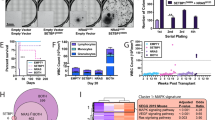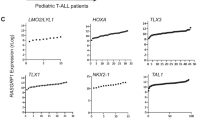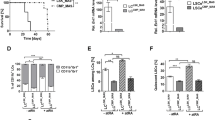Abstract
The fusion protein PML/RARA, associated with acute promyelocytic leukemia behaves as an abnormal retinoic acid (RA) receptor with altered transactivation properties but is still inducible by RA. The chimeric protein is thought to promote leukemogenesis but also paradoxically to mediate the sensitivity to ATRA of APL cells. This has been supported by works reporting that in vitro ATRA resistance is characterized by defects in the RARA/E-domain of PML/RARA. In the present report, we identified a new mutation in the E domain of PML/RARA which is associated with a RA-resistant subline of NB4 cells; NB4-R2. This mutation, identical to the Gln411 mutation found in HL60-R, changes the amino acid Gln903 to an in-phase stop codon, generating a truncated form of PML/RARA which has lost 52 amino acids at its C-terminal end. We have studied the effect of the truncated PML/RARA protein on PML NB formation and RARA and PML/RARA transcriptional activity. We show here that the fusion mutant exerts a dominant negative effect on wild-type PML, PML/RARA and RARA transcription activity. These findings highlight the important role of the RARA E-domain of PML/RARA in mediating RA sensitivity in APL cells.
This is a preview of subscription content, access via your institution
Access options
Subscribe to this journal
Receive 12 print issues and online access
$259.00 per year
only $21.58 per issue
Buy this article
- Purchase on Springer Link
- Instant access to full article PDF
Prices may be subject to local taxes which are calculated during checkout



Similar content being viewed by others
References
Chambon P . A decade of molecular biology of retinoic acid receptors FASEB J 1996 10: 940–954
de Thé H, Chomienne C, Lanotte M, Degos L, Dejean A . The t(15;17) translocation of acute promyelocytic leukemia fuses the retinoic acid receptor alpha gene to a novel transcribed locus Nature 1990 347: 558–561
Goddard AD, Borrow J, Freemont P, Solomon E . Characterization of a zinc finger gene disrupted by the t(15;17) in acute promyelocytic leukemia Science 1991 254: 1371–1374
Early M, Kakizuka A, Nason-Burchenal K, Martin P, Evans RM, Dmitrovsky E . Transgenic expression of PML/RARA impairs myelopoiesis Proc Natl Acad Sci USA 1996 93: 7900–7904
He L, Triboli C, Rivi R, Peruzzi D, Pellici PG, Soares V, Cattoretti G, Pandolfi PP . Acute leukemia with promyelocytic features in PML/RARalpha transgenic mice Proc Natl Acad Sci USA 1997 94: 5302–5307
de Thé H, Lavau C, Marchio A, Chomienne C, Degos L, Dejean A . The PML-RAR-alpha fusion mRNA generated by t(15;17) translocation in acute promyelocytic leukemia encodes a functionally altered RAR Cell 1991 66: 663–674
Kakizuka A, Miller WH, Umesomo Jr K, Warrell RP, Franckel SR, Murty VS, Dmitrovsky E, Evans RM . Chromosomal translocation t(15;17) in human acute promyelocytic leukemia fuses RARa with a novel putative transcription factor, PML Cell 1991 66: 653–674
Dyck JA, Maul GG, Miller WH, Chen JD, Kakizuka A, Evans RM . A novel macromolecular structure is a target of the promyelocyte-retinoic acid receptor oncoprotein Cell 1994 76: 333–343
Weis K, Rambaud S, Lavau C, Jansen J, Carvalho T, Carmo-Fonseca M, Lamond A, Dejean A . Retinoic acid regulatesaberrant nuclear localization of PML-PARα in acute promyelocytic leukemia cells Cell 1994 76: 345–356
Hong WK, Benner SE, Lippman SM . Evolution of aerodigestive tract 13-cis-retinoid acid chemoprevention: the MD Anderson experience Leukemia 1994 8: S33–S37
Peck GL, DiGiovanna JJ . Synthetic retinoids in dermatology. In: MB Sporn, AB Roberts, DS Goodman (eds). The Retinoids, Biology, Chemistry and Medicine, 2nd edn Raven Press: New York 1994 pp 631–657
Huang ME, Ye YC, Chen SR, Chai JR, Lu JX, Zhao L, Gu RJ, Wang ZY . Use of all-trans retinoid acid in the treatment of acute promyelocytic leukemia Blood 1988 72: 567–572
Castaigne S, Chomienne C, Daniel MT, Ballerini P, Berger R, Fenaux P, Degos L . All-trans retinoic acid as a differentiation therapy for acute promyelocytic leukemia. Clinical results Blood 1990 76: 1704–1709
Cornic M, Delva L, Guidez F, Balitrand N, Degos L, Chomienne C . Induction of retinoic acid-binding protein in normal and malignant human myeloid cells by retinoic acid in acute promyelocytic leukemia patients Cancer Res 1992 52: 3329–3334
Shao W, Benedetti L, Lamph W, Nervi C, Miller Jr W . A retinoid-resistant acute promyelocytic leukemia subclone express a dominant negative PML-RARA mutation Blood 1997 89: 4282–4289
Kitamura K, Kiyoi H, Yoshida H, Saito H, Ohno R, Naoe T . Mutant AF-2 domain of PML-RARA in retinoic acid-resistant NB4 cells: differentiation induced by RA is triggered directly through PML-RARA and its down-regulation in acute promyelocytic leukemia Leukemia 1997 11: 1950–1956
Imaizumi M, Suzuki H, Yoshinari M, Sato A, Saito T, Sugawara A, Tshuchiya S, Hatae Y, Fujimoto T, Kakizuka A, Konno T, Linuma K . Mutations in the E-domain of RARA portion of the PML-RARA chimeric gene may confer clinical resistance to all-trans retinoic acid in acute promyelocytic leukemia Blood 1998 92: 374–382
Ding W, Li Y-P, Nobile LM, Grills G, Carrera I, Paietta E, Tallman MS, Wiernick PH, Gallagher E . Leukemic cellular retinoic acid resistance and missense mutations in the PML/RARA fusion gene after relapse of acute promyelocytic leukemia from treatment with all-trans retinoic acid and intensive chemotherapy Blood 1998 92: 1172–1183
Lanotte M, Martin-Thouvenin V, Najman S, Ballerini P, Valensi F, Berger R . NB4: a maturation inducible cell line with t(15;17) marker isolated from a human acute promyelocytic leukemia (M3) Blood 1991 77: 1080–1086
Duprez E, Ruchaud S, Houge G, Martin-Thouvenin V, Valensi F, Kastner Ph, Berger R, Lanotte M . A retinoid acid ‘resistant’ t(15;17) acute promyelocytic leukemia cell line: isolation, morphological, immunological and molecular features Leukemia 1992 6: 1281–1287
Ruchaud S, Duprez E, Gendron MC, Houge G, Geniesser HG, Jarstoff B, Doskeland SO, Lanotte M . Two distincly regulated events, priming and triggering, during retinoid-induced maturation and resistance of NB4 promyelocytic cell line Proc Natl Acad Sci USA 1994 91: 8428–8432
Duprez E, Lillehaug JR, Naoe W, Lanotte M . cAMP signal is decisive for recovery of nuclear bodies (PODs) during maturation of RA-resistant t(15;17) promyelocytic leukemia NB4 cells expressing PML-RARα Oncogene 1996 12: 241–245
Mullis K, Faloona F, Scharf S, Saiki R, Horn G, Erlich H . Specific enzymatic amplification of DNA in vitro – the polymerase chain reaction Cold Spring Harbor Symp 1986 51: 263–273
Boddy MN, Howe K, Etkin LD, Solomon E, Freemont PS . PIC-1, a novel ubiquitin-like protein which interacts with the PML component of a multiprotein complex that is disrupted in acute promyelocytic leukemia Oncogene 1996 13: 971–982
Robertson KA, Emami B, Collins SJ . Retinoic acid-resistant HL-60R cells harbor a point mutation in the retinoic acid receptot ligand-binding domain that confers dominant negative activity Blood 1992 80: 1885–1889
Kastner P, Perez A, Lutz Y, Rochette-Egly C, Gaub MP, Durand B, Lanotte M, Berger R, Chambon P . Structure, localization and transcriptional properties of two classes of retinoid acid receptor a (RAR-α) fusion proteins in acute promyelocytic leukemia (APL). Structural similarities with a new family of oncoproteins EMBO J 1992 11: 629–642
Renaud JP, Rochel N, Ruff M, Vivat V, Chambon P, Gronemeyer H, Moras D . Crystal structure of the RAR-gamma ligand-binding domain bound to all-trans retinoic acid Nature 1995 378: 681–689
Lamour FPY, Lardell P, Apfel CM . Analysis of the ligand-biding domain of human retinoic acid receptor α by site-directed mutagenesis Mol Cell Biol 1996 16: 5386–5392
Pratt M, Kralova J, McBurney MW . A dominant negative mutation of the alpha retinoic acid receptor gene in a retinoic acid-non responsive embryonal carcinoma cell Mol Cell Biol 1990 10: 6445–6453
Tale BF, Grippo JF . Mutagenesis of the ligand binding domain of the human retinoic acid receptor identifies critical residues for 9-cis retinoic acid binding J Biol Chem 1995 270: 20258–20263
Moras D, Gronemeyer H . The nuclear receptor ligand-binding domain: structure and function Curr Opin Cell Biol 1998 10: 384–391
Chen JD, Evans RM . A transcriptional co-repressor that interacts with nuclear hormone receptors (see comments) Nature 1995 377: 454–457
Li Y, Gallagher RE . Retinoic acid-resistant HL60 cells exclusively contain mutant retinoic acid receptor-α Blood 1994 83: 3298–3302
Melnick A, Licht JD . Deconstructing a disease: RARA, its fusion partners, and their roles in the pathogenesis of acute promyelocytic leukemia Blood 1999 93: 3167–3215
Lo Cocco F, Nervi C, Avvisati G, Mandelli F . Acute promyelocytic leukemia: a curable disease Leukemia 1998 12: 1866–1880
Fanelli M, Minucci S, Gelmetti V, Nervi C, Gambacorti-Passerini C, Pelicci G . Constitutive degradation of PML/RARA through the proteasome pathway mediates retinoic acid resistance Blood 1999 93: 1477–1481
de Thé H, del Mar J, Vivanco-Ruiz M, Tiollais P, Stunnenberg H, Dejean A . Identification of retinoic acid responsive element in the retinoic acid receptor B gene Nature 1990 343: 177–180
Benoit G, Altucci L, Flexor M, Ruchaud S, Lillchaug J, Raffelsberger H, Gronemeyer H, Lanotte M . RAR-independent RXR signaling induces t(15;17) leukemia cell maturation EMBO J 1999 (in press)
Acknowledgements
We thank Prof P Chambon (IGBMC, Illkirsh, France) for providing us with RARA and PML-RARA expression vectors, Prof C Rochette-Egly (IGBMC, Illkirsh, France) for the generous gift of anti-RAR (F) and anti-RARA (D) rabbit polyclonal antisera. Dr P Freemont (ICRF, London, UK) is thanked for the gift of anti-PML antibody. We thank Dr A Saurin for critical reading of the manuscript. GB is the recipient of a fellowship from Association pour la Recherche contre le Cancer (ARC). MF is supported by the Association Claude Bernard. This work was supported by funds from the Institut National de la Santé et de la Recherche Médicale (INSERM), the Centre National de la Recherche Scientifique (CNRS), the Ligue Nationale contre le Cancer, and the Norwegian Research Council (grant to JLR).
Author information
Authors and Affiliations
Rights and permissions
About this article
Cite this article
Duprez, E., Benoit, G., Flexor, M. et al. A mutated PML/RARA found in the retinoid maturation resistant NB4 subclone, NB4-R2, blocks RARA and wild-type PML/RARA transcriptional activities. Leukemia 14, 255–261 (2000). https://doi.org/10.1038/sj.leu.2401683
Received:
Accepted:
Published:
Issue Date:
DOI: https://doi.org/10.1038/sj.leu.2401683
Keywords
This article is cited by
-
A novel network pharmacology approach for leukaemia differentiation therapy using Mogrify®
Oncogene (2022)
-
STMN1 is highly expressed and contributes to clonogenicity in acute promyelocytic leukemia cells
Investigational New Drugs (2022)
-
Antagonism between granulocytic maturation and deacetylase inhibitor-induced apoptosis in acute promyelocytic leukaemia cells
British Journal of Cancer (2015)
-
Retinoic acid synergizes ATO-mediated cytotoxicity by precluding Nrf2 activity in AML cells
British Journal of Cancer (2014)
-
WIPI-dependent autophagy during neutrophil differentiation of NB4 acute promyelocytic leukemia cells
Cell Death & Disease (2014)



